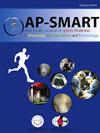Changes in the position of the medial meniscus owing to degenerative meniscus tears
IF 1.4
Q3 ORTHOPEDICS
Asia-Pacific Journal of Sport Medicine Arthroscopy Rehabilitation and Technology
Pub Date : 2025-01-22
DOI:10.1016/j.asmart.2025.01.002
引用次数: 0
Abstract
Background
While meniscal extrusion has been recognized as a key factor in meniscal dysfunction and osteoarthritis (OA) development, the specific movement of the posterior horn of the medial meniscus (MM) during extrusion, particularly in early-stage OA, remains unexplored. Therefore, in this study, we investigated the position of the MM in patients with medial knee pain and a Kellgren–Lawrence grade ≤1, investigating the relationship between meniscal extrusion and degenerative tears. We hypothesized that the MM extrusion (MME) would be larger when degenerative tears are present; the anterior horn would move posteriorly, and the posterior horn would move anteriorly, accordingly.
Methods
A total of 181 knees (mean age 61.7 ± 12.1 years; 97 men and 84 women) were included. Simple radiographs were used to measure the weight-bearing line ratio and medial proximal tibia angle. Magnetic resonance imaging was used to measure the medial proximal tibia slope, medial meniscus extrusion, anterior and posterior horn position, and degenerative tears on the posterior segment of the medial meniscus. Those with degenerative tears were designated as group T and those without were designated as group C. Student's t-test and Pearson's χ2 test were performed to compare groups T and C. Statistical significance was set at p < 0.05.
Results
Group T had a significantly larger medial posterior tibial slope (group T: 7.4 ± 2.3°; group C: 6.6 ± 2.2°, p = 0.010) and medial meniscus extrusion (group T: 2.7 ± 1.4 mm; group C: 1.9 ± 1.2 mm, p < 0.001) scores compared with group C. Furthermore, the posterior point of the anterior horn (group T: 16.3 ± 5.0 %; group C: 14.3 ± 3.8 %, p = 0.004) and anterior point of the posterior horn (group T: 36.4 ± 7.1 %; group C:26.9 ± 5.9 %, p < 0.001) were significantly larger in group T than in group C.
Conclusion
Degenerative MM tears cause not only MME but also an anteroposterior shift.
由于退行性半月板撕裂引起的内侧半月板位置的改变
虽然半月板挤压已被认为是半月板功能障碍和骨关节炎(OA)发展的关键因素,但内侧半月板(MM)后角在挤压过程中的具体运动,特别是在早期OA中,仍未被研究。因此,在本研究中,我们研究了内侧膝关节疼痛且kelgren - lawrence分级≤1的患者MM的位置,研究半月板挤压与退行性撕裂之间的关系。我们假设当存在退行性撕裂时MM挤压(MME)会更大;前角向后移动,后角也相应地向前移动。方法共181例膝关节(平均年龄61.7±12.1岁;包括97名男性和84名女性)。采用简单x线片测量负重线比和胫骨内侧近端角。采用磁共振成像测量胫骨内侧近端斜度、内侧半月板挤压、前后角位置、内侧半月板后段退行性撕裂。有退行性撕裂者为T组,无退行性撕裂者为c组。T组与c组比较采用学生T检验和Pearson χ2检验,p <为差异有统计学意义;0.05.结果T组胫骨后内侧斜度明显增大(T组:7.4±2.3°;C组:6.6±2.2°,p = 0.010)和内侧半月板挤压(T组:2.7±1.4 mm;C组:1.9±1.2 mm, p <;此外,前角后点(T组:16.3±5.0%;C组:14.3±3.8%,p = 0.004)、后角前点(T组:36.4±7.1%;C组:26.9±5.9%,p <;结论退行性MM撕裂不仅会引起MME,还会引起前后移位。
本文章由计算机程序翻译,如有差异,请以英文原文为准。
求助全文
约1分钟内获得全文
求助全文
来源期刊
CiteScore
3.80
自引率
0.00%
发文量
21
审稿时长
98 days
期刊介绍:
The Asia-Pacific Journal of Sports Medicine, Arthroscopy, Rehabilitation and Technology (AP-SMART) is the official peer-reviewed, open access journal of the Asia-Pacific Knee, Arthroscopy and Sports Medicine Society (APKASS) and the Japanese Orthopaedic Society of Knee, Arthroscopy and Sports Medicine (JOSKAS). It is published quarterly, in January, April, July and October, by Elsevier. The mission of AP-SMART is to inspire clinicians, practitioners, scientists and engineers to work towards a common goal to improve quality of life in the international community. The Journal publishes original research, reviews, editorials, perspectives, and letters to the Editor. Multidisciplinary research with collaboration amongst clinicians and scientists from different disciplines will be the trend in the coming decades. AP-SMART provides a platform for the exchange of new clinical and scientific information in the most precise and expeditious way to achieve timely dissemination of information and cross-fertilization of ideas.

 求助内容:
求助内容: 应助结果提醒方式:
应助结果提醒方式:


